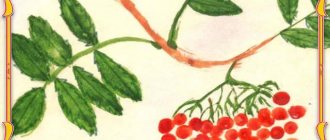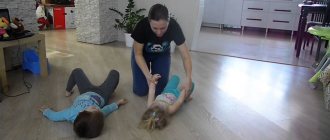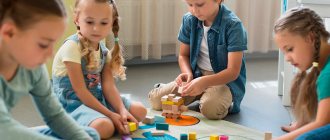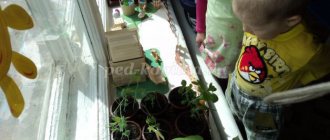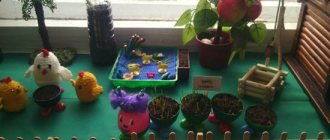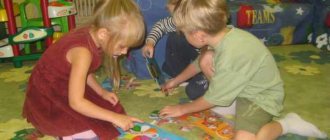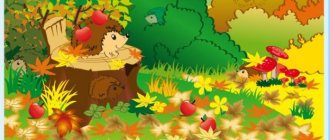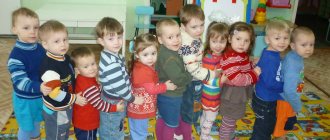Nursery rhymes in the younger group of kindergarten: a large selection of nursery rhymes for children
Nursery rhymes for preschoolers in the junior group of kindergarten are a special collection of rhymes with a more complex meaning than for infants, but with the same useful developmental potential, new words and the ability to develop the speech of a 1, 2 or 3 year old child.
Among the nursery rhymes intended for such a small child, finger games are very popular, to which a separate block of our nursery rhymes is dedicated. However, here you will find a lot of useful works for the development of not only motor skills, but also the baby’s mental abilities, memory, and articulation.
- Finger-boy, where have you been? - I went to the forest with this brother. I cooked cabbage soup with this brother. I ate porridge with this brother. I sang songs with this brother!
- Okay, okay, where were you? - By Grandma! - What did you eat? - Porridge! - What did you drink? - Mash! Porridge is buttery, Mash is sweet, Granny is kind. They drank, ate, flew home, sat on their heads, and began to sing.
- Forty, forty! Where were you? - Far! She lit the stove, cooked porridge, jumped on the threshold - called guests. The guests arrived and sat down on the porch. She gave to this, She gave to this, She gave to this, She gave to this, But she didn’t give to this: He didn’t walk on water, He didn’t chop wood, He didn’t light the stove, He didn’t cook porridge...
A horned goat is walking, a butted goat is walking, her legs are stomping, her eyes are clap-clap. Those who don’t eat porridge, don’t drink milk, gore, gore, gore.
The night came, brought darkness; The cockerel dozed off, the cricket began to sing. It’s late, son, lie down on your side, bye-bye, go to sleep...
Kitty, kitten-cat, Kitty - gray tail! Come, kitty, spend the night, rock my baby, lull her to sleep.
Bye-bye, bye-bye, let's buy felt boots for our son, put them on his little feet, and let's go down the path. Our son will walk and wear new felt boots.
Bye-bye-bye-bye, Don't lie on the edge. A little gray top will come, He will grab the barrel. He will grab you by the barrel and drag you into the woods, under the broom bush. Don’t come to us, little top, don’t wake up our baby.
The mice are dancing in circles, the cat is dozing on the bed. Hush, mice, don't make noise, don't wake up Vaska the Cat. When Vaska the cat wakes up, he will break up the whole round dance.
Cockerel, cockerel, Golden comb, Butter head, Silk beard! Why do you get up early, sing loudly, and don’t let Vanya sleep?
The grass ant rose from its sleep, the tit bird took the grain, the bunny took the cabbage, the mice took the crust, the boys took the milk.
Rain, rain, more. The grass will be thicker, the leaves will be greener, the berries will be redder.
Rainbow-arc, Don't let it rain. Come on sunshine, Bellflower!
Our ducks in the morning - quack-quack-quack! Quack-quack-quack! Our geese by the pond - Ga-ga-ga! Ha-ha-ha! And the turkey in the middle of the yard - Ball-ball-ball! Bullshit! Our little girls at the top - Grru-ugrr! Grru-ugrr! Our chickens through the window - Ko-ko-ko! Ko-ko-ko-ko! And how Petya the Cockerel, Early, early in the morning, will sing to us cuckoo!
Long-term project in the 1st junior group “Rhymes for Kids”
Project duration: 09.2020 - 06.2021
Project participants: children, parents and teachers of the 1st junior group.
“The task of an adult is to reveal to a child the miracle that a book contains.”
A nursery rhyme is a small genre of oral folk art, a song-sentence directly related to a gesture.
Relevance. At a young preschool age, nursery rhymes play a special role, and the unique uniqueness of the sound speech flow is especially valuable. Simple rhyme, emotional coloring, sound combinations and their melodiousness create the effect of musicality. Therefore, a nursery rhyme, first of all, serves as an assistant in developing the sound culture of speech. Speech hearing and pronunciation of sounds also develop. The nursery rhyme contains many bright and colorful word pictures, which allows you to learn new forms of words denoting objects. Reading nursery rhymes occurs with many repetitions, which helps memorize words and then use them. The content of many nursery rhymes is rich in verbs. And as a result, the child’s vocabulary is enriched. Along with this, the formation of the grammatical structure of speech and the development of monologue and dialogic speech occur. During the period of early preschool age, nursery rhymes are the most understandable, interesting, musical and educational means for a child, which make it possible to lay a solid foundation for the psychophysical development of a child in the preschool period of childhood.
Recently, we often hear the statement “people have stopped reading.” From conversations and observations of communication between parents and children, it can be assumed that modern parents really communicate little and read books to their children, due to their employment or dependence on modern media (Internet , TV, all kinds of gadgets).
To clarify, we invited parents to answer the “Child and Book” questionnaire as part of Children’s Book Week. From the results of the survey, it is clear: all parents who took part in the survey read books to their children (100%), which is very gratifying. 60% read to children several times a week, 30% daily, and 10% rarely. Half of the parents read at the child’s request, and the other half both at the child’s request and on their own initiative. All respondents have books at home: there are poems and fairy tales, nursery rhymes, and additionally encyclopedias. Half of the parents surveyed said that at home their children talk about what they read in kindergarten. It is gratifying that all parents read various literature: fiction, educational, periodicals, which is very pleasing. From the analysis of the questionnaires, we concluded that parents are involved in the development of their children, but for this they do not have enough time and ideas about the benefits of folklore (nursery rhymes) and memorizing short works for children of primary preschool age.
Folklore is one of the most effective and vibrant means, fraught with enormous didactic opportunities. Acquaintance with folk works enriches children's feelings and speech, shapes their attitude towards the world around them, and plays an invaluable role in all-round development. Children's folklore is a vast area of oral folk poetry. This is a whole world - bright, joyful, filled with vitality and beauty.
Taking into account the relevance of this issue, I developed the project “Rhymes for Kids”, the goal of which was to form an emotionally positive attitude towards the book through folklore.
Project objectives:
- Development of children's speech, enrichment and activation of vocabulary.
- Cultivating a caring attitude towards books.
- Formation of the need for reading.
- Increasing the level of development of speech activity.
- Acquaintance with the surrounding natural world, with the way of life and way of life of the Russian people.
- Involving parents in creating conditions for developing children's interest in books at home and in kindergarten.
Expected results of the project:
- There is an emotional responsiveness of children to the listened works of folklore.
- The range of children's reading has been expanded.
- The child's vocabulary has been enriched.
- The need to read a book is formed.
- Parents were active in creating conditions for the development of children's interest in books.
Project product:
creating a card index “Rhymes for Kids”
- creating a book “Our Favorite Nursery Rhymes” together with parents, followed by viewing at a parent meeting. Creation of a lapbook “Reading to Children”, a children’s book “Rhymes, Songs”.
Working with parents
Questionnaire “Child and Book” (Appendix 1)
- Conversation “The role of nursery rhymes in the development of young children” (Appendix 2)
- Book exhibition “Reading with Children”
- Folder “How and what to read to children 2-3 years old”
- Booklet “Reading to Children”
Construction of work taking into account the following principles: clarity, consistency, activity, continuity with the family, variability. Methods: verbal conversations, storytelling, reading fiction, listening to audio recordings, looking at books, illustrations, albums, didactic games, showing theatrical performances, participating in leisure, entertainment, and holidays.
Literature:
- Batyaeva S.V., Savostyanova E.V. Album on speech development for the little ones. M.: ZAO ROSMEN-PRESS, 2010. 88 p.
- Vinnikova G.I. Classes for children 2-3 years old: development of speech, fiction, visual arts. Sphere shopping center, 2009. 128 p.
- Caramel" for kids (songs, nursery rhymes, fairy tales, poems). M.: Omega, 2007.
Contents of self-education work for the 2020-2021 academic year
September. Selection of material necessary for working with children and parents on the topic “Development of speech in young children through folklore.” Studying the topic, setting goals and objectives on this topic. Planning.
October. Learning and reciting nursery rhymes with children in everyday life. Questioning of parents on the topic: “The child and the book”, parent meeting “The role of nursery rhymes in raising a child.”
November. Studying the topic “Printed board games based on Russian folk tales.” Joint and independent examination of illustrations and pictures. Creation of creative works “My Favorite Fairy Tale” together with parents. Decorating a book corner on the theme “Rhyme Songs”.
December. Decoration of the “Our Creativity” corner. Studying the topic “Theatrical games as a means of developing children’s speech.” Enrichment of the dressing area. Learning poems and songs for the New Year, theatrical performance “Gifts of Santa Claus.” Finger games on the theme “winter”.
January. Decorating a theatrical corner in a group, making a theater based on Russian folk tales. Studying the topic: “Use of folklore in working with children.” Watching the presentations “Such different nursery rhymes” with children.
February. Studying the topic: “Use of folklore in working with children.” Joint and independent examination of illustrations and pictures. Using nursery rhymes while washing, dressing, undressing, and preparing for bed. Consultation for parents “The role of folklore in the development of children.”
March. Getting to know nursery rhymes and poems about mom. Entertainment “Sunny, like mom.” Consultation “Speech and fingers”. Participation in the general holiday “Farewell to Maslenitsa”, didactic games “Find out which nursery rhyme is an excerpt from”, “Find out the nursery rhyme”.
April. Studying the topic “introduction to chants, nursery rhymes about the sun.” Entertainment "Little suns - helpers of the big sun." Creating a card index of nursery rhymes. Creation of the book “Favorite Nursery Rhymes” together with parents.
May. Consultation for parents “How to learn poetry correctly.” Parent meeting “Our successes”. Replenishment of the development environment: lacing games, sports corner. Learning nursery rhymes about animals. Entertainment “Forest animals visiting children.” Quiz game "Fairy-tale heroes".
Self-analysis of the self-education plan. Presentation of the project “Development of children’s speech through folklore.”
Expected result
By the end of the year, the children's vocabulary was enriched with new words, phrases, and expressions. The pronunciation of sounds became clearer and more expressive. Primary skills in perceiving the phonemic and lexical aspects of speech have been formed.
An interest in oral folk art and fiction arose.
Parents develop an interest and understanding of the need to use small forms of folklore in speech development.
The development environment of the group in this direction has been enriched.
The children remembered a lot of nursery rhymes, songs, and Russian folk tales.
Memory and attention have improved.
We draw nursery rhymes: NOD “The sun is shining...”
Long-term planning for reading fiction in the first junior group
Ekaterina Khudyshkina
Long-term planning for reading fiction in the first junior group
Long-term planning for reading fiction in the first junior group.
week Program content
2 Reading the nursery rhyme “Our Masha is little...”
S. Kaputikyan’s poem
“Masha is having lunch”
- help children understand the content of the nursery rhyme, pay attention to the words alenka, black-browed; make you want to listen to the nursery rhyme more than once; introduce the poem; learn to finish onomatopoeic words and small phrases found in Gerbov’s poem 68
3 Reading a fairy tale by V. Suteeva “Chicken and Duckling”
Purpose: to introduce the fairy tale, to give an idea of the appearance of the duckling, to practice the correct use of the word also Gerbova 34
4 Reading a poem by G. Sapgira “Cat”
D\pr
"Pussy does not leave us!"
- explain to children how differently you can play with a toy and talk to it; help repeat and come up with simple appeals to the toy Gerbova 78
week Program content
1 Repetition of familiar fairy tales Reading the nursery rhyme “Cucumber, cucumber...”
- recall familiar fairy tales with children, help children dramatize excerpts from works; help me remember Gerbov's new nursery rhyme 63
2 Reading the German folk song “Three Merry Brothers”
- develop the ability to listen to a poetic text, repeat onomatopoeic words, perform the movements mentioned in Gerbov’s text 32
3 Russian folk song “The cat went to market...”
. Pies for a cat - introduce the content of a folk song; learn to listen and answer the teacher’s questions; form round lumps of plasticine;
4 Reading the story E. Charushin "Chicken"
— teach children to perceive
literary text without visual accompaniment; enrich vocabulary; encourage repeating individual words when re- reading Gerbova's story Week 45
Program content
1 Reading the Russian folk tale “Teremok”
- introduce children to a fairy tale, make them want to play in a fairy tale
2 Reading the story E. Charushin "Hedgehog"
-introduce a new story, develop the ability to listen silently, without distraction; introduce the habits of the hedgehog Gerbov 104
3 Reading the Russian folk tale “Turnip”
— introduce children to Gerbov’s new fairy tale 57
4 Reading a fairy tale by L. Tolstoy's "Three Bears"
— to teach children to listen to large-scale works; evoke an emotional response; form intonation expressiveness of speech Gerbov 60
week Program content
1 Reading the Ukrainian folk tale “Rukavichka”
- introduce a new fairy tale, make you want to return to it more than once, teach you how to solve Gerbov’s riddles 50
2 Reading a fairy tale by V. Suteeva “Who said meow?”
— to develop skills in perceiving
of art by ear, learning to depict the actions of characters , expressively conveying dialogues from Gerbov’s fairy tale n 53
4 Nursery rhyme “Oh, you little bastard…”
. - repeat the nursery rhyme with the children; teach to guess animals by description, develop attention, teach to ask and answer questions;
week Program content
1 Reading the poem I. Akim “The Christmas tree is dressing up”
- help children remember and learn to independently recite Gerbov’s poem 56
2 Reading the Russian folk tale “Zayushkina’s hut”
-introduce children to a new fairy tale, help them understand its content, and evaluate the actions of the characters; make you want to play Gerbov's fairy tale 91
3 Reading a fairy tale by V. Bianki "The Fox and the Mouse"
- introduce children to the work of V. Bianchi, teach them to help the teacher read a fairy tale, finishing the words and small phrases of Gerbov 89
4 Reading the Russian folk tale “Masha and the Bear”
— teach children to listen to a fairy tale, participate in the dramatization of individual episodes, and form intonation expressiveness of speech; teach Gerbov's retelling 75
week Program content
1 Reading a fairy tale S. Marshak "The Tale of a Stupid Mouse"
— introduce children to a new work, teach them to listen to a poetic text, and practice clear pronunciation of onomatopoeia. Gerbova 37
3 Reading a fairy tale S. Marshak "Mustachioed-Striped"
introduce children to a new work, make them want to listen to it repeatedly, finish the words missed by the teacher Gerbova 102
